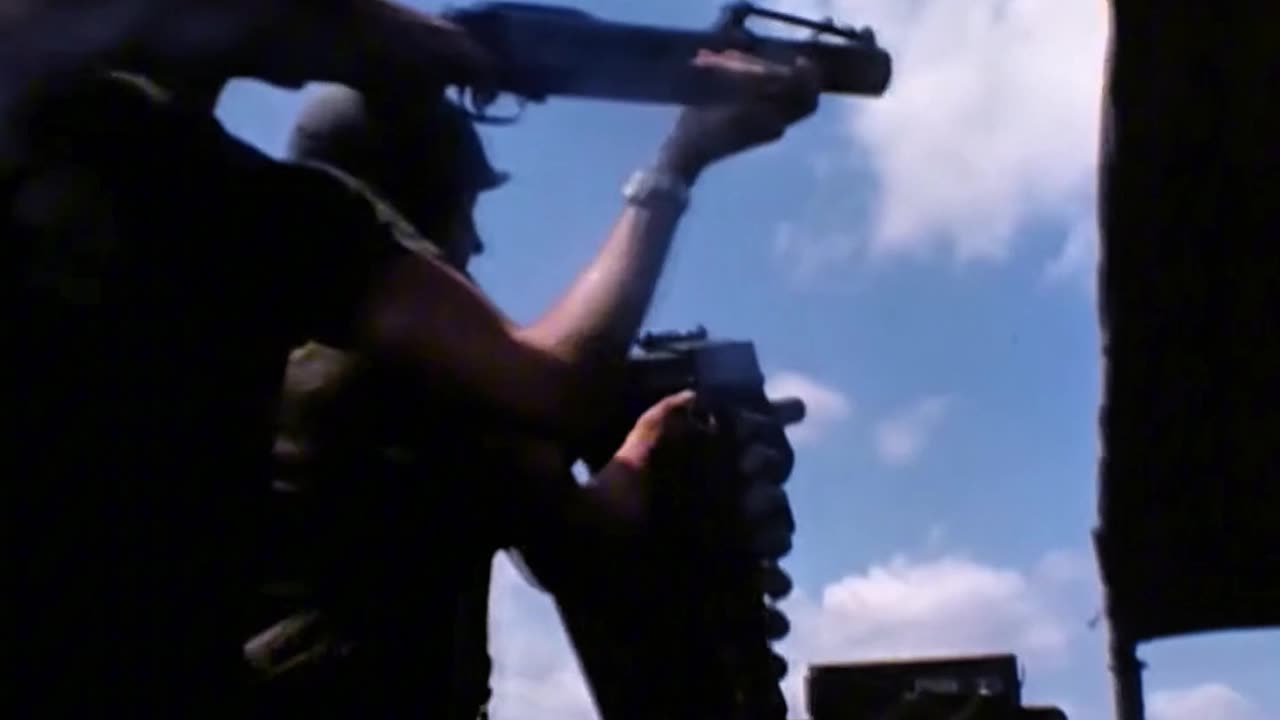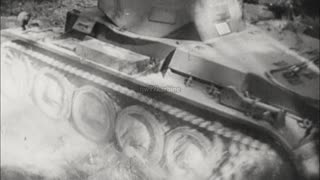Premium Only Content

Honeywell Mark 18 hand-cranked 40mm Grenade Launcher in action on a PBR in March 1969
The M79 was not the final answer to using the new 40mm low velocity ammunition by the US military. Other avenues of research had been going forward since the first adoption of the M79 in 1960. The idea of an automatic weapon firing the 40mm family of grenades had been brought forward and examined by a number of civilian companies. The Honeywell Corporation first introduced the concept of a rapid fire grenade launcher to their designers in 1962. Honeywell had been heavily involved in the design of the fuzes for the 40mm grenades and the concept of a mechanical grenade launcher was proposed during an in-house meeting on fuzes.
Instead of developing a fully-automatic grenade launcher, the Honeywell engineers suggested that a mechanical repeater be done instead. Instead of trying to adapt a standard automatic weapons design to the characteristics of the 40mm grenade, a hand-cranked repeater would be much simpler to produce in a very short time. The idea was moved forward as an in-house development with no government contract pending. By 1965, the first launcher was ready for demonstration.
In place of a normal chamber, the new launcher had two rotors the length of the cartridge case. Each rotor had six semicircular grooves cut in its length, each half the circumference of a 40mm round. The two rotors were geared together so that a 40mm round would be held in a complete chamber made up from the two rotor halves. Since the chamber formed around the cartridge, the normal functions of chambering and extracting didn’t have to happen. This gave the Honeywell a very simple operating system with relatively few parts.
The two rotors were driven by a side-mounted crank handle, much the same as an old Gatling gun. The rotors were locked into place by a cam driven rod as the firing pin was cocked and dropped by another cam. Rotating the crank handle fired the Honeywell when the handle was at the top or bottom of a rotation, launching two grenades for each full revolution. Depending on how fast the operator turned the handle, the Honeywell would fire at rates of 1 to 250 rounds per minute.
Ammunition for the Honeywell was placed in a plastic belt, spaced out at proper intervals. The initial belts were nothing more than fiberglass-reinforced sticky tape, with the rounds stuck between two lengths of the tape. Spacing of the rounds in the tape belt was done with two tape clinching wheels (large gears) in a special loading machine. The tape belt gave a great deal of trouble when the weapon was introduced and were quickly replaced by a stronger system.
The new belts for the Honeywell were made of Mylar-backed Dacron fabric with pockets between heat-sealed sections of the belt. The fabric belts were supplied in 24 or 48 round lengths and could be reloaded about five times before they wouldn’t hold the 40mm round firmly enough. Old fabric belts sometimes were seen in Vietnamese and other hands being used as 40mm bandoleers.
The Honeywell was examined by the Navy in 1965 for possible adoption as a small boat weapon. Testing proved the system and the Honeywell received the nomenclature assignment of Gun, Rapid Fire, 40mm Mark 18 Mod 0 on 10 December 1965. Between 1965 and 1968, when production ceased, about 1,200 Mk 18 launchers were produced, almost all production going to the US Navy.
Though the Mk 18 could produce a good deal of firepower, it was considered a temporary, stopgap weapon until a self-powered design could be developed. There wasn’t a secure seal between the cartridge case and the barrel so propellant gases leaked out, limiting the muzzle velocity. Accuracy suffered as a result. Volume of fire was considered the Mark 18’s main advantage.
The Mk 18 was able to fire an entire belt of 48 rounds as fast as a man could turn the handle. By carefully sweeping the weapon back and forth, starting at the longest range (400 meters) and working back, a football-field sized area could be covered with one 48-round belt of ammunition. Properly done, all of the grenades would impact at roughly the same time due to the high lobbing arc of the 40mm grenade.
-
 2:04
2:04
hw97karbine
1 month agoPanzer I and II tanks transported by truck and trailer on maneuvers in 1939
95 -
 1:24:56
1:24:56
Glenn Greenwald
7 hours agoTrump Declares Cities as the Enemies Within; Reagan Appointed Judge Slams Trump Over Speech Crackdowns; American ER Doctor on Gaza Atrocities | SYSTEM UPDATE #524
121K88 -
 LIVE
LIVE
I_Came_With_Fire_Podcast
13 hours agoPete Hegseth and the Chamber of Standards | Digital IDs | Taiwan Chips & Salsa | CDL Crisis
347 watching -
 2:01:46
2:01:46
Adam Does Movies
13 hours ago $0.26 earnedTalking Movies + Ask Me Anything - LIVE
14.9K -
 29:11
29:11
Nick Shirley
5 hours ago $2.62 earnedPortland has Fallen... ANTIFA Take Control of City
16.9K31 -
 1:19:00
1:19:00
VapinGamers
5 hours ago $0.74 earnedJump Space - We All Scream in Space - Early Access - !rumbot !music
16.1K1 -
 1:50:12
1:50:12
Joker Effect
4 hours ago(Kick) Streamers Have Ruined The Streaming Landscape and Here is How! Reviewing Phase Partners...
23.2K1 -
 3:46:40
3:46:40
The Blood Lust Gaming
7 hours agoClair Obscur: Expedition 33 - LVL 1 challenge run pt.3
12.4K -
 2:11:38
2:11:38
Nikko Ortiz
6 hours agoPTSD Is Fun Sometimes | Rumble LIVE
22.2K2 -
 1:02:40
1:02:40
BonginoReport
7 hours agoA Florida Man Attempts a Jussie Smollett Hoax - Nightly Scroll with Hayley (Ep. 146)
136K74